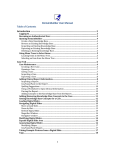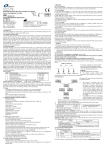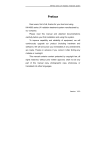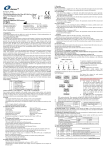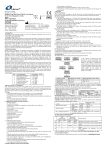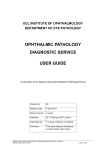Transcript
Revision No.: ZJ0007 Issue Date: Jul 1st, 2012 Vibrio Vulnificus Real Time PCR Kit User Manual For In Vitro Diagnostic Use Only DD-0129-01 For use with LightCycler1.0/2.0 Instrument Obelis S.A. Boulevard Général Wahis 53 1030 Brussels, BELGIUM Tel: +(32) 2.732.59.54 Fax: +(32) 2.732.60.03 E-Mail : [email protected] Shanghai ZJ Bio-Tech Co., Ltd. www.liferiver.com.cn Tel: +86-21-34680596 [email protected] Fax: +86-21-34680595 nd 2 floor,No.15 Building,No.188 Xinjunhuan road, PuJiang Hi-tech Park Shanghai China 1. Intended Use Vibrio Vulnificus real time PCR kit is used for the detection of Vibrio vulnificus in stool, food, blood or water samples by using real time PCR systems. 2. Principle of Real-Time PCR The principle of the real-time detection is based on the fluorogenic 5’nuclease assay. During the PCR reaction, the DNA polymerase cleaves the probe at the 5’ end and separates the reporter dye from the quencher dye only when the probe hybridizes to the target DNA. This cleavage results in the fluorescent signal generated by the cleaved reporter dye, which is monitored real-time by the PCR detection system. The PCR cycle at which an increase in the fluorescence signal is detected initially (Ct) is proportional to the amount of the specific PCR product. Monitoring the fluorescence intensities during Real Time allows the detection of the accumulating product without having to re-open the reaction tube after the amplification. 3. Product Description Vibrio vulnificus is a species of Gram-negative, motile, curved, rod-shaped bacteria in the genus Vibrio. Present in marine environments such as estuaries, brackish ponds, or coastal areas, V. vulnificus is closely related to V. cholerae, the causative agent of cholera. Vibrio vulnificus causes an infection often incurred after eating seafood, especially oysters; the bacteria can also enter the body through open wounds when swimming or wading in infected waters, or via puncture wounds from the spines of fish such as tilapia. Symptoms include vomiting, diarrhea, abdominal pain, and a blistering dermatitis that is sometimes mistaken for pemphigus or pemphigoid. Vibrio Vulnificusreal time PCR kit contains a specific ready-to-use system for the detection of the Vibrio Vulnificususing PCR (polymerase chain reaction) in the real-time PCR system. The master contains reagents and enzyme for the specific amplification of the Vibrio VulnificusDNA. Fluorescence is emitted and measured by the real time systems´ optical unit during the PCR. The detection of amplified Vibrio Vulnificus DNA fragment is performed in fluorimeter channel 530nm with the fluorescent quencher BHQ1. An external positive control defined as 1×107 copies/ml is supplied which allow the determination of the gene load. For further information, please refer to section 9.2 Quantitation. 4. Kit Contents Ref. Type of reagent Presentation 25rxns 1 DNA extraction buffer 2 vials, 1.5ml 2 Vibrio Vulnificus Reaction Mix 1 vial, 480µl 3 PCR Enzyme Mix 1 vial, 12µl 4 Molecular Grade Water 1 vial, 400µl 7 5 Vibrio Vulnificus Positive control(1×10 Copies/ml) 1 vial, 30µl Analysis sensitivity: 1×103 copies/ml ; LOQ:2×103~1×108 copies/ml. Note: Analysis sensitivity depends on the sample volume, elution volume, nucleic acid extraction methods and other factors .If you use the DNA extraction buffer in the kit, the analysis sensitivity is the same as it declares. However, when the sample volume is dozens or even hundreds of times greater than elution volume by some concentrating method, it can be much higher. 5. Storage • All reagents should be stored at -20°C. Storage at +4°C is not recommended. • All reagents can be used until the expiration date indicated on the kit label. • Repeated thawing and freezing (>3x) should be avoided, as this may reduce the sensitivity of the assay. • Cool all reagents during the working steps. • Reaction mix should be stored in the dark. 6. Additionally Required Materials and Devices • Biological cabinet • Real time PCR system • Desktop microcentrifuge for “eppendorf” type tubes (RCF max. 16,000 x g) • Vortex mixer • Real time PCR reaction tubes/plates • Cryo-container • Pipets (0.5µl – 1000µl) • Sterile filter tips for micro pipets • Sterile microtubes • Disposable gloves, powderless • Biohazard waste container • Refrigerator and Freezer • Tube racks 7. Warnings and Precaution • Carefully read this instruction before starting the procedure. • For in vitro diagnostic use only. • This assay needs to be carried out by skilled personnel. • Clinical samples should be regarded as potentially infectious materials and should be prepared in a laminar flow hood. • This assay needs to be run according to Good Laboratory Practice. • Do not use the kit after its expiration date. • Avoid repeated thawing and freezing of the reagents, this may reduce the sensitivity of the test. • Once the reagents have been thawed, vortex and centrifuge briefly the tubes before use. • Quickly prepare the reaction mix on ice or in the cooling block. • Set up two separate working areas: 1) Isolation of the RNA/ DNA and 2) Amplification/ detection of amplification products. • Pipets, vials and other working materials should not circulate among working units. • Use always sterile pipette tips with filters. • Wear separate coats and gloves in each area. 8. Sample Collection, Storage and transportation • Collect samples in sterile tubes; • Specimens can be extracted immediately or frozen at -20°C to -80°C. • Transportation of clinical specimens must comply with local regulations for the transport of etiologic agents 9. Procedure 9.1 DNA-Extraction DNA extraction buffer is supplied in the kit. Please thaw the buffer thoroughly and Spin down briefly in the centrifuge before use. 9.1.1 Stool or food sample 1) Take about 50mg stool or 1000mg food samples to a tube; add 1.0ml normal saline then vortex vigorously. Centrifuge the tube at 13000rpm for 2 minutes, carefully remove and discard supernatant from the tube without disturbing the pellet. 2) Add 100µl DNA extraction buffer, close the tube then resuspend the pellet with vortex vigorously. Spin down briefly in a table centrifuge. 3) Incubate the tube for 10 minutes at 100°C. 4) Centrifuge the tube at 13000rpm for 5 minutes. The supernatant contains the DNA extracted and can be used for PCR template. 9.1.2 Water sample 1) Take 3 ml water to a tube, Centrifuge the tube at 13000rpm for 2 minutes, carefully remove and discard supernatant from the tube without disturbing the pellet. 2) Add 100µl DNA extraction buffer, close the tube then vortex for 10 seconds. Spin down briefly in a table centrifuge. 3) Incubate the tube for 10 minutes at 100°C. 4) Centrifuge the tube at 13000rpm for 5 minutes. The supernatant contains the DNA extracted and can be used for PCR template. 9.1.3 Blood sample 1) Take 2ml anticoagulation, and transfer the plasma layer and buffy-coat layer to another tube after it is natural stratified. 2) Add 100µl DNA extraction buffer into the tube, and close the tube then vortex for 10 seconds. Spin down briefly in a table centrifuge. 3) Incubate the tube for 10 minutes at 100°C. 4) Centrifuge the tube at 13000rpm for 5 minutes. The supernatant contains DNA extracted and can be used for PCR template. Attention: A. During the incubation, make sure the tube is not open,as the vapor will volatilize into the air and may cause contamination if the sample is positive. B. The extraction sample should be used in 3 hours or store at -20°C for one month. C. Different DNA extraction kits are available. You may use your own extraction systems or the commercial kit based on the yield. For the DNA extraction, please comply with the manufacturer’s instructions. 9.2 Quantitation The kit can be used for quantitative or qualitative real-time PCR. For performance of quantitative real-time PCR, Standard dilutions must prepare first as follows. Molecular Grade Water is used for dilution. The step of dilution is not needed for performance of qualitative real-time PCR. Take positive control (1×107copies/ml) as the starting high standard in the first tube. Respectively pipette 36ul of Molecular Grade Water into next three tubes. Do three dilutions as the following figures: To generate a standard curve on the real-time system, all four dilution standards should be used and defined as standard with specification of the corresponding concentrations. Attention: A. Mix thoroughly before next transfer. B. The positive control contains high concentration of the target DNA. Therefore, be careful during the dilution in order to avoid contamination. 9.3 PCR Protocol The Master Mix volume for each reaction should be pipetted as follows: 1) The volumes of Reaction Mix and Enzyme Mix per reaction multiply with the number of samples, which includes the number of the controls,standards and sample prepared. Molecular Grade Water is used as the negative control. For reasons of unprecise pipetting, always add an extra virtual sample. Mix the master mix completely then spin down briefly in a centrifuge. 2) Pipet 18µl Master Mix with micropipets of sterile filter tips to each Real time PCR reaction plate/tube. Then separately add 2µl DNA sample, positive and negative controls to different reaction plate/tubes. Immediately close the plate/tubes to avoid contamination. 3) Spin down briefly in order to collect the Master Mix in the bottom of the reaction tubes. 4) Perform the following protocol in the instrument: 37°C for 2min 1cycle Selection of fluorescence channels 94°C for 2min 1cycle 530nm Target Nucleic Acid 93°C for 5sec, 60°C for 30sec 40cycles ( Fluorescence measured at 60°C) 10.Threshold setting: Choose Arithmetic as back ground and none as Noise Band method, then adjust the Noise band just above the maximum level of molecular grade water, and adjust the threshold just under the minimum of the positive control. 11.Calibration for quantitative detection: Input each concentration of standard controls at the end of run, and a standard curve will be automatically formed. 12.Quality control: Negative control, positive control and QS curve must be performed correctly, otherwise the sample results is invalid. Channel Crossing point value Control 530nm Molecular Grade Water Blank Positive Control(qualitative assay) ≤35 QS(quantitative detection) Correlation coefficient of QS curve≤-0.98 13. Data Analysis and Interpretation The following results are possible: Crossing point value Result Analysis 530nm 1# Blank Below the detection limit or negative 2# Positive; and the software displays the quantitative value ≤35 3# Re-test; If it is still 35~40, report as 1# 35~40 For further questions or problems,please contact our technical support at [email protected]
